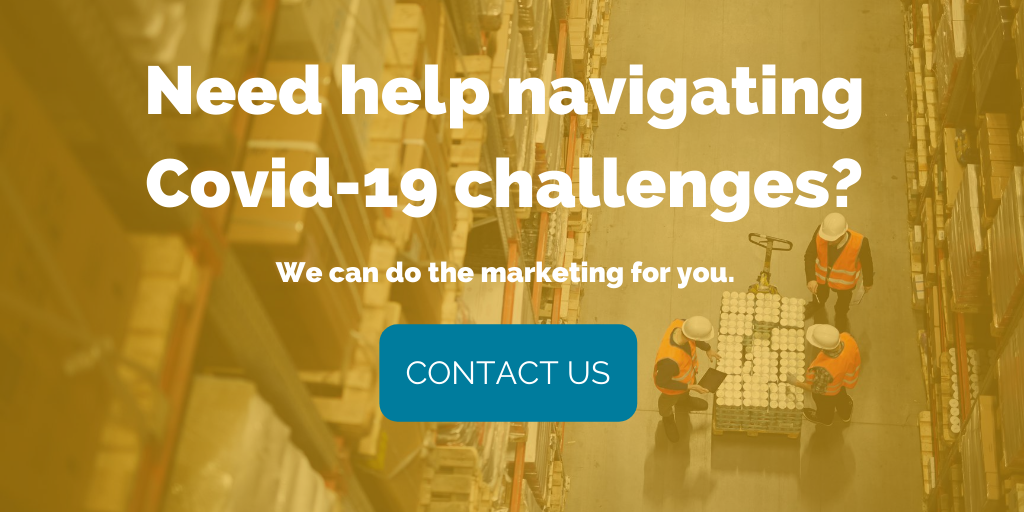
by Fronetics | Jun 9, 2020 | Blog, Content Marketing, Covid-19, Marketing, Strategy, Supply Chain
Too busy? Don’t want to invest in-house? Here are 4 prime reasons organizations opt to outsource content marketing.
No other lead generation tactic is more important to technology marketers than content assets. The new Gartner research — trade shows come in second place — shows the importance of paying heavy attention to how your organization positions itself online. If the Covid-19 repercussions left you no choice but to cut back on marketing or if you have been juggling more than ever, consider the case for outsourcing content marketing to stay competitive and excel.
At a time when some of the biggest supply chain trade shows have been either canceled or postponed, count on content assets to grow in significance. Is your organization up to the task?
In our work with both supply chain startups and multi-national corporations, we have noted a few returning reasons for outsourcing content marketing.
Do you recognize yourself or your organization in any of the following?
Outsourcing content marketing: 4 reasons organizations decide to seek outside help
Too much to do
When content marketing is the umpteenth task on an endless to-do list, the results will suffer. This scenario is particularly common among startups where everyone is wearing as many hats as possible in anticipation of the next round of funding. The haphazard approach to what is being published on social channels and on the blog does the company no favors and leaves the person in charge — frequently with limited marketing experience — feeling frustrated. Instead of letting keyword-optimized content carve out a brand niche and build website SEO, the effort goes nowhere although the will to succeed is strong.
The alternative: Partner with a content marketing agency and turn the focus on your core expertise.
No consistency
The effectiveness of content marketing relies on consistency. But being consistent is a major challenge for supply chain companies, especially when trying to recover from months of unprecedented disruption. As we explained in this post, consistency feeds SEO. Let it slip, and you lose in the online search race. In this case, sudden trade show cancelations may have forced the in-house marketing team to a quick pivot, from executing the company marketing strategy to pouring all efforts into making trade show contingency plans. Add a product launch to the mix and chances are content production will come to a standstill.
The alternative: Keep SEO humming and your online presence strong with an outsourced marketing team invested in your success.
Desire to scale but costs are too high
Needs can arise quickly. There may be a trend that a company wants to jump on or a sudden change in the business environment that warrants the need to scale up content marketing quickly. Several of our clients have sought out Fronetics because they lacked certain marketing capabilities and did not necessarily want or have the resources to make the investment in-house. That is particularly true under current circumstances when some organizations are battling budget constraints and disruption. If an organization wants to capitalize on video marketing, for instance, it can be both time-consuming and costly to train team members or go through a rigorous hiring process.
The alternative: Leverage a team out outsourced content experts to fill the gap without adding fixed costs.
Lack of analysis
The motions of content marketing are repetitive — researching, strategizing, executing, analyzing, revising — but they are so for a reason. Even the most well-intentioned content strategy can fail when an organization does not act on analytics. But for busy organizations, it is not uncommon for those last pieces of the puzzle — analyzing and revising — to be left undone.
What types of content worked well this quarter? How did the email messaging fare? What was the click-through-rate? During the past few months, when disruption ruled, it is hardly surprising if not every step was optimally performed. Yet, it can all the same be damaging to the overall success of the marketing effort if the metrics are allowed to go unnoticed for too long.
The alternative: Let content count with an outsourced marketing team that constantly needs to prove ROI.
Considering the significance of content assets, it pays to do it well. Is outsourcing content marketing right for you?

Read more:

by Fronetics | Jun 2, 2020 | Blog, Covid-19, Marketing, Strategy
Company priorities have shifted in the wake of Covid-19. Revising B2B buyer personas is important to reaching them on the right terms.
The fallout of Covid-19 indefinitely altered the supply chain. Even months after the first shockwave, companies are adjusting to new circumstances that bring new priorities when they look for partnerships and make purchasing decisions.
If your organization went through a first round of marketing plan updates back in March to reflect the new reality, time has come to take a second look at revising B2B buyer personas. But we realize time is of the essence. Few companies have days to spare for the rigor of examining every detail of what makes a target audience tick.
Yet, it pays to get the personas just right. If your messaging is not calibrated to their current needs and pain points, the effort may be largely wasted.
An example:
Let’s say you offer an inventory solution and your marketing pitch and channels remain the same pre- and post Covid-19 even as shippers, carriers, and logistics managers say there may be a paradigm shift when it comes to future sourcing and inventory management. The fact is you may be missing an optimal opportunity to position your product in a whole new light that resonates with current buyers and also has the potential to reach an untapped audience.
5 questions that will help you revise B2B buyer personas
So, what is the quick route to revising B2B buyer personas to extract the most important details? It really comes down to nailing the answers to five key questions — while avoiding getting bogged down in trivia that has no bearing on how the persona relates to your product offering or service (leave the search for the perfect persona pic for another time).
1. What are the top three priorities of your buyer persona?
This question relates to the problems or objectives that the buyer dedicates time, budget, and political capital too. Although many end-users of supply chain solutions have been able to step off the rollercoaster ride of the past few months, some will be dealing with bumpy patches for the unforeseeable future while others are adjusting to a brand-new business landscape. A retailer that pre-Covid-19 was focused on speeding up deliveries may now be consumed with dealing with suppliers to secure inventory.
Question to ask yourself: How can you align your product/service with the new priorities of your target audience?
2. How does the buyer identify success?
Take a look at the tangible or intangible metrics and rewards that the buyer uses to measure success. Is the buyer hoping his or her contributions will lead to a promotion? Is the buyer focused on acquiring a certain number of clients, improving internal organization, or generating revenue growth? If an IT-manager before Covid-19 tried to demonstrate cost savings to upper management, focus may now have switched to successfully implementing cross-department workflows.
Question to ask yourself: Can your product/service play a role in helping the buyer achieve the desired success?
3. What are the challenges the buyer is trying to overcome?
The answer to this question has likely changed significantly for your buyers. A shipper that just a few months ago faced a predictable environment may now deal with a shortage of cross-docking facilities in addition to shipping restrictions that change across state lines.
Questions to ask yourself: Does your product or service fit into your buyer’s new reality? How can you alleviate the challenges?
4. What does the buyer’s journey look like?
Again, anticipate considerable adjustments. With the cancellation or postponement of trade shows that many view as one of the most important opportunities to network and connect, your buyers will have to take the search for solutions elsewhere. Since technology and service providers rank content assets as the most effective lead-generating tactic (trade shows come in a close second), it is not a far-fetched guess that buyers will seek out digital channels to research and initiate contact. In the process of revising B2B buyer personas, identify where your target audience is spending their time.
Question to ask yourself: Which channels will be the most effective in reaching potential buyers?
5. What decision criteria does the buyer use?
How will the buyer compare and contrast aspects or your product or service with the alternatives? In light of the pandemic impact, budgetary constraints could play a larger role than usual. The tendency to “make do” with current solutions is also a factor that many marketers will run into. What holds true for your buyers?
Question to ask yourself: Based on the decision criteria, how can you preempt questions that may come up?
Final word
With the help of your sales team, market research, and — ideally — interviews with actual buyers as well as prospects who eventually picked a competitor, you can craft relevant, up-to-date B2B buyer personas.
Knowing exactly who your audience is, what their goals and challenges are, where they look for information, and how they make purchasing decisions is the foundation of any marketing strategy. And when circumstances change so drastically as in recent months, revising B2B buyer personas is a crucial step to remain effective and, in the end, grow stronger.

Read more:
Cancellations call for trade show contingency plans (It’s urgent)
Supply chain marketing during Covid-19, the risk of cutting back
Covid-19 messaging strategy for supply chain companies: Getting the basics right

by Fronetics | Oct 8, 2018 | Blog, Content Marketing, Logistics, Marketing, Social Media, Strategy, Supply Chain
Social media’s ability to exponentially grow brand awareness and introduce your content to unseen audiences can’t always be measured in dollars.
One of the hardest parts about implementing a social media strategy is struggling to measure its success. While most B2B marketing professionals agree that a social media presence is crucial to any content marketing strategy, it can be hard to justify the investment when you can’t quantify the results.
“Social media is not just a spoke on the wheel of marketing. It’s becoming the way entire bicycles are built,” says Ryan Lilly, author.
This doesn’t mean that your business shouldn’t be diving — head first — into social media. With over 3.1 billion people using social media, businesses have to recognize the importance of social media as a part of a robust marketing strategy.
[bctt tweet=” With over 3.1 billion people using social media, businesses have to recognize the importance of social media as a part of a robust marketing strategy.” username=”Fronetics”]
Marketers need to start thinking about social media success in terms of potential, instead of immediate dollars.
Social media: the reach
One of the most valuable aspects of social media is the ability to engage with new audiences, all the time. That means you not only have access to a new customer base, but to their connections as well.
When your followers engage with your brand on social media, they also engage with their own personal network. This organic reach is one of the most beneficial aspects of social media — and it’s not easy to put a dollar amount on. The potential to nurture leads and ultimately impact sales are huge, but it won’t happen overnight.
Here’s Kettie Laky, Social Media Director at Fronetics, to share why you need to frame social media success in terms of potential, and not just dollars.
Video: Measure social media success in terms of potential, not just dollars.
It’s time we start thinking about social media success in this new way: in terms of potential and expanding value, rather than just immediate dollar amounts. How have you worked to measure the success of your social media strategy?
Related posts:


by Fronetics | Sep 5, 2018 | Blog, Content Marketing, Logistics, Marketing, Strategy, Supply Chain
When your content marketing and sales forces align their efforts, they form a powerful symbiotic relationship that grows your brand and your bottom line.
There’s a big misperception out there that content marketing represents some kind of threat to the job security of sales personnel. It’s absolutely true that content marketing is an inbound approach, contrary to the traditional outbound approach of a B2B sales force. But make no mistake: Content marketing is not a substitute or replacement for an expert sales staff.
[bctt tweet=” It’s absolutely true that content marketing is an inbound approach, contrary to the traditional outbound approach of a B2B sales force. But make no mistake: Content marketing is not a substitute or replacement for an expert sales staff.” username=”Fronetics”]
In fact, it’s when marketing and sales work in tandem that they’re most effective. They can help each other out to generate more leads, nurture current leads more effectively, and even help close more deals.
Content marketing helps generate a steady flow of quality leads, and it provides targeted information to usher prospects down the sales funnel. But even quality leads don’t turn into sales on their own. This is where a sales staff comes in, to take those leads and cultivate them into new business.
Content marketing and sales: Division of labor
For content marketing and sales to work seamlessly together, it’s important to have a clear idea of the role of each. They provide different touch points for leads at each stage of the buying cycle. Here’s a quick primer:
1. Forming a relationship
In this early stage of the buying cycle, your content marketing efforts go toward opening up a dialogue with potential customers. Often, potential leads’ first engagement with your brand comes when they read one of your blog posts, come across your website while searching for product solutions, or see one of your social media posts through their network.
This is when your sales staff picks up the ball, keeping that positive contact going by developing it into a conversation. It’s your sales team’s job to cultivate an ongoing personal relationship with that prospect.
2. Providing information
Now that you’ve established a relationship and your sales team is continuing a dialogue with your prospect, content marketing can step in. B2B buyers report spending more time than ever conducting research, using expert content such as vendor websites, user reviews, and social media before making purchasing decisions. The content that you share with prospects at this stage of the buyer’s journey should be designed to answer informed questions and tip the scales in your favor.
At this stage, your sales staff should be directly answering questions from prospects. When a potential customer reaches out with a query, it’s likely that he or she has done a fair amount of research. So your sales reps need to speak specifically to the customer’s needs in a way that content alone can’t do, to keep them interested and moving down the funnel.
3. Advocating for your brand
Content marketing increases brand awareness for your business. It helps elevate your brand position within the industry and keeps your business top-of-mind, even at a time when potential customers aren’t ready to make a purchase.
When a customer is preparing to make a purchase, your sales staff is the primary advocate for your brand. They should be proactive in pursuing business when customers show interest in your content or when they reach out with questions. They drive dialogue and get to know customers and how your business can help them.
A match made in heaven
When content marketing and sales work together, you’ll see the results hit your bottom line. Curating and creating great content will generate quality leads for your company. And it also empowers your sales force to build relationships with potential customers — and close the sale.
Related posts:


by Fronetics | Aug 28, 2018 | Blog, Content Marketing, Logistics, Marketing, Supply Chain
Here are our thoughts on how often your company should blog, including challenges and ways to overcome them.
Creating valuable, relevant content in a strategic and consistent manner creates demand for your products and services and drives profitable customer action. Blogging is a large part of the foundation of your content marketing strategy. If it’s not, it should be.
Blogging is a great way to attract traffic to your website, build brand awareness, and interact with new visitors. But, a question we get all the time is, “How often should my company blog?”
Blogging: frequency matters.
Blogging every once in awhile isn’t going to get you results. You need to publish quality content on a consistent basis to attract prospects to your site.
[bctt tweet=”Blogging every once and awhile isn’t going to get you results. You need to publish quality content on a consistent basis to attract prospects to your site.” username=”Fronetics”]
The reality is that the more often you blog, the more traffic and leads you’ll get. Search engines consider posting frequency in their rankings. What’s more, every time you post, you create a new opportunity to be found, to be shared, and to be linked to by other sites.
Blogging: the challenge.
The trouble in publishing more posts is balancing resources so that you’re publishing frequently but maintaining value and quality within your content. We’re big advocates of testing to find your personal sweet spot for the amount of posts your organization is able to publish to maximize traffic and leads.
When you start publishing more frequently, make sure to track your KPIs, calculate ROI, and assess whether increasing blogging frequency is right for your business. You may be surprised at the results.
Here’s Elizabeth Hines, creative/editorial director at Fronetics, to discuss how often your company should be posting blogs.
Video: How often should my company blog?
Final thoughts.
Blogging needs to be a central part of your content marketing strategy. And unfortunately, it can take a while to start drawing traffic (and eventually, leads) from your posts. But the benefits of consistent blogging make it worth it.
And don’t forget, blog posts become more credible with age. That is to say, search engines value older content that has had more time to accumulate, like social shares and referrals from other web pages. The more relevant a blog post proves itself to be to readers over time, the higher it will rank in search engine results.
Have you tried blogging more frequently? Coming up with topics can be one of the biggest challenges. But don’t worry, we’ve got you covered.
Related posts:










